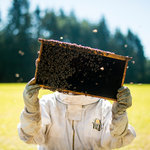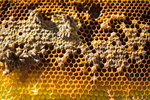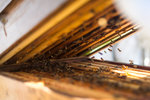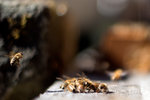



PULLMAN (AP) — Winter is a tough time for bees at the Washington State University Teaching Apiary.
In addition to frigid temperatures, honey bee colonies must battle disease and parasites. WSU researchers work to help bees fight off these threats and survive until spring.
When outside temperatures fall below 55 degrees, bees form a "winter cluster," packing tightly together and vibrating their wing muscles to keep warm.
Humans ensure that every hive is raised off the ground and every entrance angles downhill to drain rainfall and prevent rotting. They also install wire mesh screens in the entrances to ensure mice can't come inside.
WSU entomologists keep more than 200 hives on the Pullman campus and on surrounding properties in Washington and Idaho.
Bees are the world's most important pollinators.
Here's a story on the topic published in The Chronicle in September:
Born to Bee Wild: Lewis County Beekeepers Work in the Face of Parasites, Pesticides and Public Fear
By Jordan Nailon / jnailon@chronline.com
Rick Battin got his start keeping bees as a way to produce more food on his farmstead located on the top of a secluded wooded hill in Napavine.
The property has great historic fruit trees that Battin had spent time meticulously manicuring and generally primping to perfection. The problem was, not enough attention was being paid to the trees’ delicate little flowers during the short window in spring when they impatiently await nature’s pollinators to arrive and swap pollen spores while indulging on a full flute of sweet nectar.
Battin began his beekeeping experiment in 2009 with just two hives. Now, he has more than a dozen, and it appears those diligent little honeybees might be doing too good of a job.
“I don’t think they missed a flower this year,” noted Battin, who pointed out some damage to his apple trees caused by snapping limbs done in by an overload of fruit.
To be sure, though, Battin prefers a problem of abundance over the plight of scarcity.
After procuring his first two hives, Battin joined the Lewis County Beekeepers Association in 2010 in order to glean knowhow from veteran beekeepers. At one point, he even became the treasurer for the benevolent bee whisperers’ group, and all the while he kept plugging away at his own expanding apiary, and curiosity.
“As I started figuring out some of the problems with bees, I wanted to try to keep them more naturally,” explained Battin.
When Battin speaks of the problems with bees, he is referring to the mystery of colony collapse disorder, the scourge of mites, the constant threat of predators, the prevalence of pesticides in our environment and the propensity for people to unleash their misguided fears upon the poor unsuspecting honeybees as they go about their symbiotic ritual of gathering nectar for honey while pollinating flowers for our food.
Those problems are not just personal to Battin and his barrage of honeybees, though. Bees pollinate at least 30 percent of the world’s food crops and about 90 percent of all wild flowering plants, so their work is essential to the fabric of the world as we know it.
Understanding the supporting role that honeybees play on the stage of life, Battin was adamant about keeping his bees in the most natural way possible. At first, he eschewed all chemical treatments used to combat parasites in the hive, but he found out soon enough that without cheating a little bit, the losses to his colonies were too staggering to withstand.
These days, Battin fudges a little by using a common acid treatment in the hive to combat the scourge of Varroa mites that attach themselves to the backs of the bees and suck their blood while simultaneously weighing them down as they go about their efficient busy bee business. Mites may sound like some simple little bugs, but do not be fooled, these are mighty mites.
“For comparison, if a mite of equivalent size was on you it would be about the size of a rabbit,” noted Battin, who also uses a sticky board in his bottom hives in order to trap mites and keep tabs on the load for each colony.
Susanne Weil, a beekeeper who moonlights as professor of English at Centralia College, was in attendance at Battin’s farm last Saturday as an instructor for a beekeeping workshop organized by the LCBA.
While working Battin’s hives in an effort to demonstrate the relative health and food stores of each colony heading into the wet season, Weil noted that fall is fraught with peril for peaceful honeybees.
Weil explained that honeybees naturally reduce their colony population in the fall in order to conserve food for the winter. For example, male drone bees are often unceremoniously booted from the hive in late fall by fastidious female worker bees. Their fate to starve or die by elements is sealed by the hivemind of their sisters. On the contrary, mites have no inclination to decrease their numbers, and so as the bee population dwindles, the overall ratio of mites to bees increases.
Another pain in the neck for nearly all beekeepers that Weil touched on is the annual attack of yellow jacket death squads, which also tend to increase in prevalence and tenacity during the autumn.
“It’s two things. Because they are running out of food. They're out after honey or brood. Anything they can get their hands on,” explained Weil. “The best thing to do with the yellow jackets is to put traps out in the spring … Basically it’s kill them before they can kill the bees.”
The fight between honeybees and yellow jackets is not a particularly fair bout since yellow jackets can be two to three times larger than honeybees and come equipped with a non-barbed stinger that allows them to sting as many bees as they desire. Conversely, a honeybee’s barbed stinger detaches and remains inserted in their foes after the first penetration. The removal of their stinger simultaneously rips the honeybees innards out and sentences them to a selfless death in the name of their colony mates.
Battin agreed with Weil’s assessment, noting to the throng of beekeepers in attendance on Saturday that, “I had a big time yellow jacket problem in the past.”
In order to combat that persistent attack, Battin has taken to using entrance reducers on his hives year round in an effort to eliminate opportunities for the yellow jackets to enter the beehive in the first place.
“All of that activity really helps to keep the yellow jackets out,” said Battin. “They’re usually going to land on the side and try to sneak in a way that nobody is looking.”
Battin also uses a metal screen bottom board on his hive during the summer time. The screen board increases airflow and allows some mites to fall out the bottom of the hive. Moreover, Battin believes that the screened entrance draws the yellow jackets to the underside of the hive where the scent of honey permeates the air. The only problem for the yellow jackets is that there is no way inside from down below.
“You can sometimes hear them chewing on the metal trying to get in … ping, ping, ping,” said Battin.
Dan Maughan, community outreach coordinator for the LCBA, was also on hand at Battin’s farm on Saturday as an instructor. His advice for battling the invasion of yellow jackets is to keep your hives big and strong.
“If you have a large beehive population you will have plenty of defense,” said Maughan.
He also noted that yellow jackets tend to only fly about 200 yards in search of food while honeybees will travel up to 2 miles with ease. With that in mind, Maughan said one easy solution is to move hives away from the location of the yellow jackets’ nest. On the other hand, if you know exactly where an underground yellow jacket nest is, Maughan said his favorite method of eradication is to bury the nest entrance beneath rocks or soil in order to trap them below ground.
As a last resort of sorts, Maughan acknowledged that common wasp/hornet/yellow jacket sprays are effective, if a bit dangerous to the health of nearby honeybees. He noted that while most bug spray residues do not retain toxicity for long, he still has mixed feelings about the use of pesticides because of their unintended consequences. This summer, he lost two hives when a nearby field was sprayed to eradicate aphids. Maughan calls the use of pesticides a “true concern.”
However, if it’s a paper wasp nest that a person is trying to kill, Maughan says go right ahead.
“If you take that can and spray it right up in that little hole you’re not going to get any bees. There aren’t any bees hanging out there, otherwise they’d be food.”
Maughan says that one of the biggest obstacles in protecting honeybees while battling their aggressive cousins is to appreciate the difference between the species.
“One of the best ways to do that is to remind people that bees are herbivores and yellow jackets, wasps and hornets are all carnivores,” said Maughan. He compared the difference to that of a domestic cow versus a wild bear. “Yes, a cow can inflict damage, but not on the same level as a bear or a wolf.”
Maughan explained that in Pacific Northwest there are three types of insects that are commonly confused with honeybees.
The first is the black bald face hornet (“You really know when you’ve been stung by one of those.”) and the second is paper wasps, which tend to be trash eaters but still elicit calls from confused citizens who mistake their conical paper nests with a true beehive. Lastly, there are four different species of yellow jackets common to this area, the smallest of which is regularly mistaken for a bee.
Maughan believes that a little education and an altered perspective on what honeybees do for people would make a significant difference in the overall health of honeybee populations. He wants people to think of honeybees more like a milking cow or a draft horse.
“The other thing to remember is that in an area like this with Rick (Battin), if he were a shepherd these would be his sheep. They would be his livestock. He cares for them and we should respect them as such,” said Maughan. “It’s a form of agriculture that we need to know and respect.”
Wild bees also play an important role in the world’s ecology. There are wild honeybees and mason bees and of course the many iterations of the bumbling bumblebee. Maughan believes that protecting those wild stocks, especially wild honeybees and their unique gene pool, will prove vital to the survival of both bees and humans going forward.
“The wild bees are the ones that have learned to survive. Right now we have so many problems with the bees that to find bees that can survive on their own is impressive,” said Maughan.
For his part, Battin has already joined the wild pollinator party. He has set up native mason bee clusters all around his property, and in an effort to draw in bees, birds, bats and butterflies, he grows a pollinator garden each year. His goal with the garden is to produce flowers that will bloom out of sync of the natural nectar flow, thereby extending the peripherals of the foraging season and allowing the pollinators, his honeybees included, to put away additional food stores in advance of the long wet winter.
In his pollinator garden, Battin grows a variety of plants, including sunflowers, lavender and buckwheat. One of his, and more importantly, the bees favorite delicacies though is the flower of the borage plant, which blooms from May until the first frost of fall. Borage is uniquely suited to the needs of bees too, by growing a flower that points down to the ground so that they do not fill up with water during rainstorms, thus allowing bees to get right to work pollinating as soon as the skies clear.
In beekeeping, there are many lessons to be learned from the work of the hive. The most applicable and beneficial to the bees themselves is the force of synergy and collective effort. Not one beekeeper can keep enough bees to pollinate the world. Similarly, there is not one single trick that will ensure a healthy and long thriving hive. Like a honeybee dutifully packing away grains of pollen, each good faith effort by a beekeeper is a deposit toward a more secure future for us all.
It is a battle of abundance over scarcity.